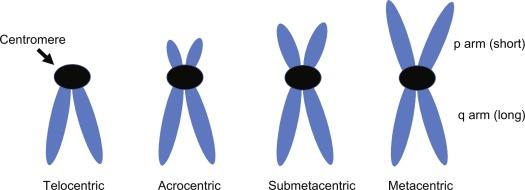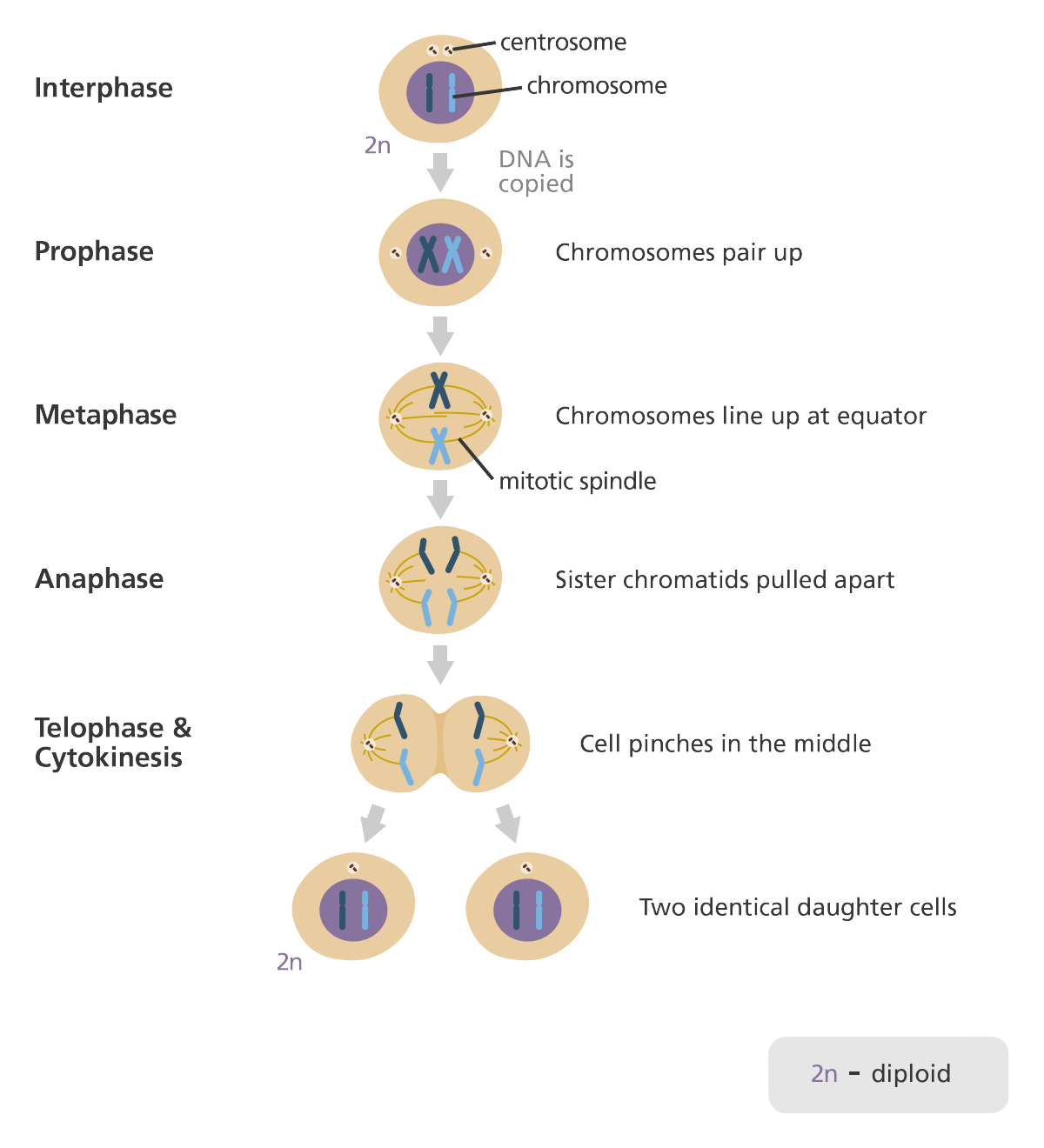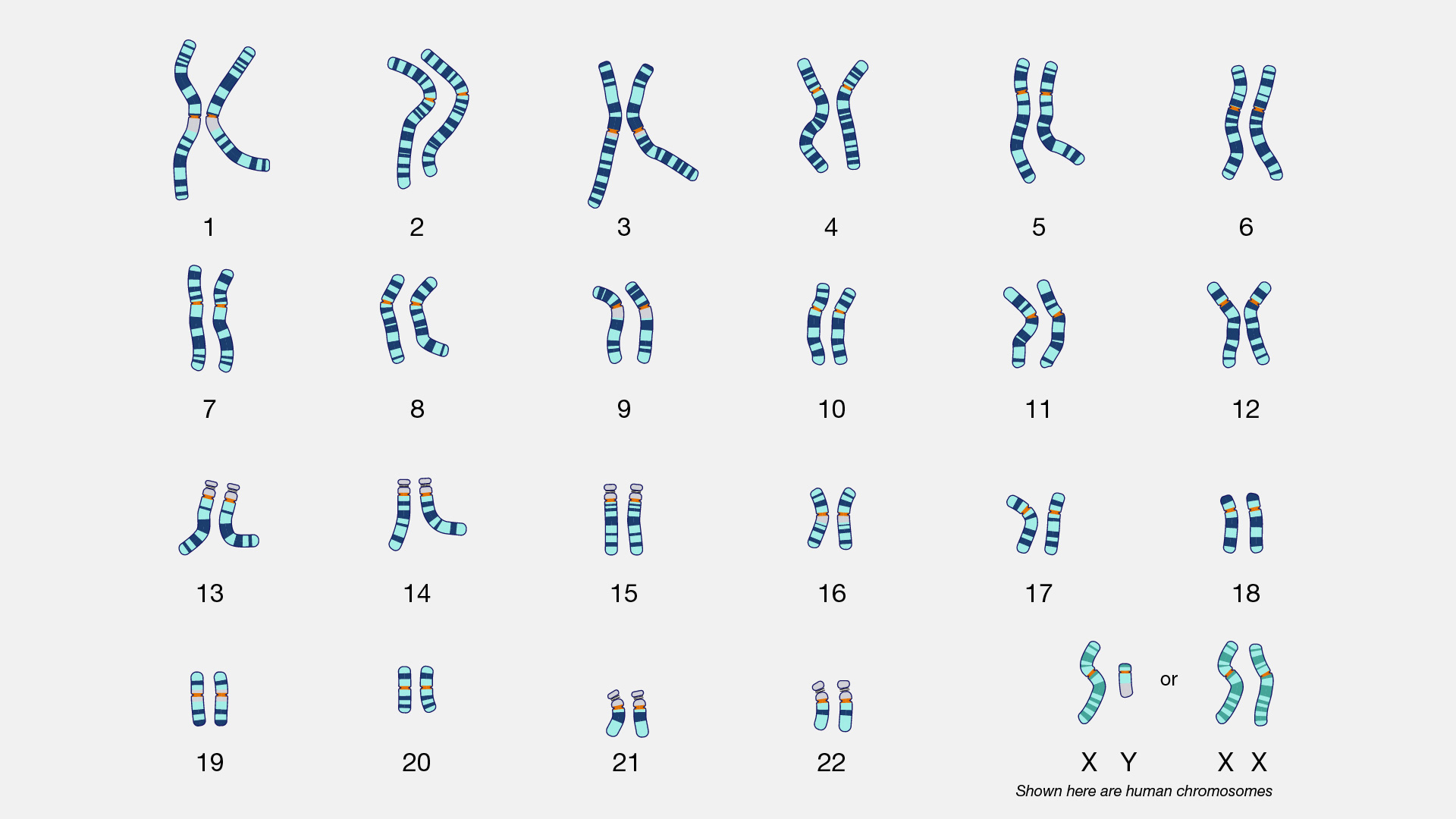
GN 301 Module 2: Cell Cycle and Chromosomes
Chromosome Structure
Chromosome parts: A chromosome is 15% DNA, 10% RNA and 75% Protein
Label the parts of a chromosome and centromere positions (Draw them)
Metacentric, Submetacentric, Acrocentric, Telocentric
Metacentric: the centromere is in the middle of the chromosome
Submetacentric: the centromere is slightly off-center
Acrocentric: the centromere is very off-center
Telocentric: the centromere is at the top of the chromosome

The Cell Cycle
G1
Gap 1. Cells accomplish much of their growth, growing larger and making proteins and organelles needed for DNA synthesis.
S
S-phase. The cell synthesizes a copy of the DNA in its nucleus.
G2
Gap 2. The cell grows more as it makes more proteins and organelles, reorganizing its contents in
preparation for mitosis.
M
M-phase. Nuclear division (mitosis) followed by cytoplasmic division (cytokinesis)

Mitosis
Prophase, prometaphase, metaphase, anaphase, and telophase
What is Cytokinesis?
The cytoplasmic division of a cell at the end of mitosis or meiosis, bringing about the separation into two daughter cells.
Interphase = G1 + S + G2
When is there one chromatid and when are there 2 chromatids (sister chromatids) on the centromere?
During anaphase, there are two chromatids on the centromere. During Telophase, there is just one chromatid on the centromere.

Chromosome Preparation
Colchicine does… destroy spindle fibers in a cell so the view of chromosomes is unobstructed
Hypotonic Salt solution does ….. increase the cell volume
Dropping cells from height does …. splinter them apart by force, which reveals chromosomes
Homologous Chromosomes have the same: length, centromere, position, banding pattern, and genetic loci.
Karyotype
Define: an organized array of a cell’s chromosomes
Autosomes: non-sex chromosomes
Sex Chromosomes: X or Y chromosomes
Describe arrangement in karyotype: homologous chromosomes are matched together
Karyotypes can show whether an individual has a genetic disorder based on the appearance or absence of chromosomes.

FISH technique
FISH stands for … Fluorescent in situ Hybridization
Purpose: to use fluorescent DNA probes to target specific chromosomal locations within the nucleus, resulting in colored signals that can be detected using a fluorescent microscope
GN 301 Module 2: Cell Cycle and Chromosomes
Chromosome Structure
Chromosome parts: A chromosome is 15% DNA, 10% RNA and 75% Protein
Label the parts of a chromosome and centromere positions (Draw them)
Metacentric, Submetacentric, Acrocentric, Telocentric
Metacentric: the centromere is in the middle of the chromosome
Submetacentric: the centromere is slightly off-center
Acrocentric: the centromere is very off-center
Telocentric: the centromere is at the top of the chromosome

The Cell Cycle
G1
Gap 1. Cells accomplish much of their growth, growing larger and making proteins and organelles needed for DNA synthesis.
S
S-phase. The cell synthesizes a copy of the DNA in its nucleus.
G2
Gap 2. The cell grows more as it makes more proteins and organelles, reorganizing its contents in
preparation for mitosis.
M
M-phase. Nuclear division (mitosis) followed by cytoplasmic division (cytokinesis)

Mitosis
Prophase, prometaphase, metaphase, anaphase, and telophase
What is Cytokinesis?
The cytoplasmic division of a cell at the end of mitosis or meiosis, bringing about the separation into two daughter cells.
Interphase = G1 + S + G2
When is there one chromatid and when are there 2 chromatids (sister chromatids) on the centromere?
During anaphase, there are two chromatids on the centromere. During Telophase, there is just one chromatid on the centromere.

Chromosome Preparation
Colchicine does… destroy spindle fibers in a cell so the view of chromosomes is unobstructed
Hypotonic Salt solution does ….. increase the cell volume
Dropping cells from height does …. splinter them apart by force, which reveals chromosomes
Homologous Chromosomes have the same: length, centromere, position, banding pattern, and genetic loci.
Karyotype
Define: an organized array of a cell’s chromosomes
Autosomes: non-sex chromosomes
Sex Chromosomes: X or Y chromosomes
Describe arrangement in karyotype: homologous chromosomes are matched together
Karyotypes can show whether an individual has a genetic disorder based on the appearance or absence of chromosomes.

FISH technique
FISH stands for … Fluorescent in situ Hybridization
Purpose: to use fluorescent DNA probes to target specific chromosomal locations within the nucleus, resulting in colored signals that can be detected using a fluorescent microscope
 Knowt
Knowt
